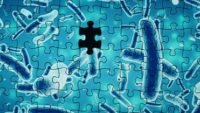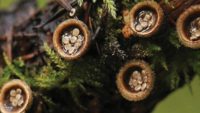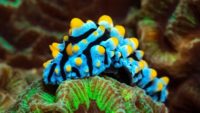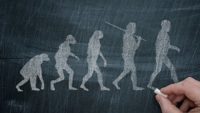By Ken Ham For decades scientists have debated when, how, and where the first life supposedly evolved. Various hypotheses abound: maybe RNA came first; perhaps life evolved around hydrothermal vents; maybe life arrived on an asteroid—but none have satisfied everyone, due to significant problems with each one. And now an old idea has been revived and refined: maybe there was a “chemical big bang,” and life arose spontaneously in a river, with all the major components in place all at once. As this article from New Scientist states, It has long been thought that the ingredients for life came together [More]
Sneak peek of a powerful article from the latest Creation magazine. More headaches for the ‘millions of years’ story …read more Source: creation.com
By Dr. Elizabeth Mitchell Countless people have been convinced by the wonders of the developing embryo—falsely portrayed—that evolution must be true. Why is this falsified idea still accepted by many teachers and scientists? …read more Source: AIG Daily
Once again, results are better when aquaculture imitates the natural life cycle of Atlantic salmon.1,2 In other words, the closer fish farmers get to imitating God’s natural program for anadromous fish life cycles, the healthier it is for the fish being farmed.3 This is no surprise for biblical creationists, but this has been a new learning experience for secular scientists. More… …read more Source: icr.org
Did people believe in apemen before Darwin? …read more Source: creation.com
By Dr. Gordon Wilson The forest is full of unseen wonders. Consider just one common type of fungus on the forest floor. …read more Source: AIG Daily
What effect did long-lived men having children have on human genetic diversity? …read more Source: creation.com
By Melinda Christian The words “slug” and “festive display of color” don’t usually come to mind at the same time. Fun facts about nudibranchs or sea slugs. …read more Source: AIG Daily
If you were standing in a field of tomatoes, you might be surprised to know that the soil underneath your feet is teeming with electrical signals being sent among plants as described in a new research study.1 These results continue to expand the startling complexity of plant adaptation and point directly to an Omnipotent Creator who engineered it all. In 2013, a study was published showing that plants signaled each other… More… …read more Source: icr.org
Recent research from the Okinawa Institute of Science and Technology Graduate University (OIST) continues to highlight how evolutionary theory influenced scientists to foolishly conclude that DNA in organisms not used to code for proteins (termed “non-coding” DNA) is useless “junk.” A press release highlighted an OIST scientist’s paper published in Nature Communications that identified a specific genomic reg… More… …read more Source: icr.org
New genetic evidence shows that humans may share DNA with super-archaic humans. …read more Source: creation.com
In America, the month of July is accompanied by fireworks, even in the heavens.1 However, July is also a time when certain glow-in-the-dark animals—creatures of the sky and sea—shine forth their own “night lights.”2 Two such examples are noted here: lightning bugs in the air, and jellyfish in the sea. Both of these animals are bioluminescent. These creatures produce biochemical oxidatio… More… …read more Source: icr.org
The latter days of July are very busy for many pollinators.1 These include birds, bees, butterflies, moths, beetles, flies, bats, and more.1-3 Pollination is essential to a healthy planet. Humans, wildlife, and agriculture benefit enormously from the supposedly simple practice of airborne animals transferring pollen from one flowering plant to another.1,2 More… …read more Source: icr.org
Dog genetics present a huge problem for evolution. Despite many centuries of breeding producing many varieties, from Chihuahuas to Great Danes, dogs are still dogs. …read more Source: creation.com
Recent research on the flying behavior of Alaskan alcids shows how Earth has two kinds of fluid-filled “oceans”, the liquid ocean of sea-water and the gaseous “ocean” of air.1-3 (Alcids are auk-like birds, such as murres, guillemots, and puffins.) The study reveals that these birds, from the Alcidae family which includes puffins, murres and their relatives, produ… More… …read more Source: icr.org
Most people might be surprised to learn that the human genome has not been fully sequenced. Gaps still remain that have not yet been bridged because of the nature of the DNA sequence coupled with past limitations on DNA sequencing technology. Nevertheless, a study has just been published using new and improved technologies that have allowed for the first complete sequence of a human chromosome.1 Sequencing the complete h… More… …read more Source: icr.org
For centuries, mercury has been used in thermometers for reading our body temperatures, but now we measure mercury levels to see if seafood is safe to eat.1-4 If you are hungry for fish, maybe trout would be a good choice.1 Nearly half of all gamefish in freshwater lakes, streams and rivers in the Chesapeake Bay watershed may be unsafe to eat because of high levels of mercury… More… …read more Source: icr.org
Did the 1918 Spanish Flu virus really go extinct, as genetic entropy predicted? …read more Source: creation.com
Beluga whales don’t select their friends according to what Darwinists would expect, a new Florida Atlantic University study shows.1,2 The research findings are taken from ten Arctic beluga whale ranges, including Alaska’s Yakutat Bay, Cook Inlet, Norton Sound, Canada’s Husky Lakes, Russia’s Gulf of Anadyr, and a small population by Norway’s Svalbard.2 More… …read more Source: icr.org
A recent science news video shows barium-marked fluoroscopy of a ghost crab’s gut teeth in action. The video reveals how that species of crab can control friction of its gastric mill teeth (i.e., teeth inside its digestive gut) in order to communicatively project growling noises.1 Gut teeth are well-known as components in crab digestive systems, since crabs (like lobsters and crayfish) have no teeth in their mouths. … More… …read more Source: icr.org
The United Nation’s Intergovernmental Panel on Climate Change (IPCC) has recently claimed that agriculture is a major producer of greenhouse gases and should be considered a climate “villain.” However, the calculations that formed the basis of these claims completely neglected the fact that crop plants scrub the atmosphere of carbon dioxide on a massive scale, and thus help lower greenhouse gasses. This flawed global warming res… More… …read more Source: icr.org
By Dr. David Menton How the fossil record, evolutionary assumptions, artistic license, and anatomical differences do NOT confirm common ancestry between humans and apes. …read more Source: AIG Daily
Photosynthesis in plants starts with the absorption of light energy from sunlight, but scientists have been baffled as to how plants utilize the noisy solar spectrum to power the photosynthetic process. By applying engineering principles used to construct wireless antennae reception and energy transfer in human-designed systems, scientists uncovered an ingenious system of design for light harvesting in plants.1 Photosynt… More… …read more Source: icr.org
Is flight an easy trait to lose? …read more Source: creation.com
A new species of a split-footed lacewing was recently unearthed in British Columbia, Canada, creating a bit of controversy among secular paleontologists.1 All living relatives of this insect reside exclusively in Australia today.1 So, why are fossils of this insect found in Canada? Bruce Archibald of Simon Fraser University and Vladimar Makarkin of the Russian Academy of Sciences in Vladivostok tried to explai… More… …read more Source: icr.org
By Rich Wendling God placed within small seeds an astonishing ability to move mountains, which even pyramid builders sought to imitate. …read more Source: AIG Daily
This ‘dirty secret’ of modern-day Darwinism blows a hole in evolutionary theory a mile wide! …read more Source: creation.com











































